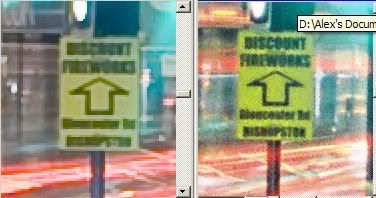I've dabbled a bit in using digital SLR cameras but I still have my film SLR as well as a number of fixed lens RFs, now I'm thinking of investing in a dedicated film scanner. Question is, what will give the best all round quality (all other things being equal) a film scanner such as the Plustek 7400 or a budget DSLR/compact system camera such as the Olympus E-PL1? Anybody got any experience they would like to share?
Well, there is no easy answer.
I am an engineer and have tested this intensively over the years.
Most films, combined with very good lenses, deliver much more resolution than a 12 MP DSLR.
Chip resolution is limited by the Nyquist frequency, that is a physical limit, it is impossible to get more.
With an 12 MP APS-C sensor you get real 65-70 lp/mm resolution (that is bit lower than the Nyquist frequency because of the low pass filter which reduces resolution a bit further).
Film resolution is not limited by the Nyquist frequency.
At medium contrast yo can get about 130 lp/mm with Delta 100, or about 120 lp/mm with Provia 100F, and about 80 lp/mm with Ektar 100.
And more than 200 lp/mm with high resolution BW films.
With higher contrast the resolution of film will be even higher.
At Carl Zeiss they tested that and got 170 lp/mm with Vlevia 50 and 140 lp/mm with Ektachrome 100, and about 200 lp/mm with T-Max 100.
And 400 lp/mm with Agfa HDP / Adox CMS 20 / Spur Orthopan UR (tests were published in the camera lens news 17, 19, 20, 24, 30).
With optical printing in the wet darkroom with excellent enlarging lenses it is possible to transfer almost all of this resolution onto paper. The loss in resolution is very small, about 5%.
Same with slide projection with quality projecting lenses, minimal losses in detail, comparable to optical printing.
Also the same viewing slides with excellent slides loupes on a lighttable. No visible quality loss.
With these two options you get by far the best quality, the best detail, resolution, sharpness and finest grain out of your film.
The problems begin with scanning: Then you will loose significant detail.
A Nikon Coolscan 5000 scanner with nominal 4000 dpi (real it achieves 3600 dpi) is able to resolve about 70 lp/mm.
The Reflecta you mentioned is significantly worse.
4000 dpi scanner are not able at all to resolve all the information which is recorded on film.
Optical printing and slide projection are far superior in this respect.
If you like film, it's aesthetic and all the other advantages, use it and get the best from it by projection and optical printing.
By the way, projection is not only extremely impressive by it's unsurpassed brillance with color, but also with BW slides. It's breathtaking, BW slides have a unique tonality.
You can't get that with BW prints.
Cheers, Jan


